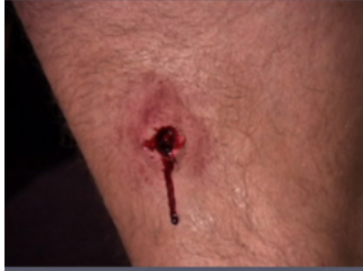types of wounds and explanations
1/9
There's no tags or description
Looks like no tags are added yet.
Name | Mastery | Learn | Test | Matching | Spaced |
|---|
No study sessions yet.
10 Terms
what are all the types of wounds
VULNUS SCISSUM – cut wound
vulnus contusum - bruise/ abrasion
vulnus laceratum - tearing
vulnus lacero- contusum
vulnus punctum - puncture
vulnus morsum- bite wound
vulnus scloropectum - gunshot wound
cut/surgical wounds
1. VULNUS SCISSUM
Incisions/ scalpel/ knife/ surgical wound
Regular, straight edges come to a point
length is greater than the depth- slash not stab
clean margins, easier surgical closures
• (1°) Primary Healing
oppose separated edges (suture/strips/glue)
minimal scarring
faster recovery
• Can cut through tendons, vessels, nerves
functio leasa = (loss of function)
• BLEEDING
Due to clean-cut transection of blood vessels.
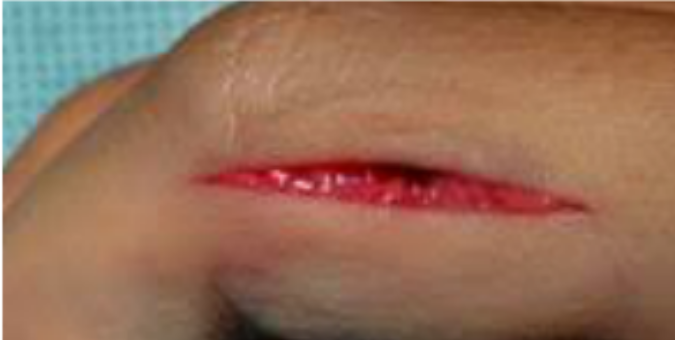
what type of bleeding occurs from vein vs artery
Arterial bleeding: bright red, spurting.
Venous bleeding: dark red, steady flow.
bruises/abrasions
VULNUS CONTUSUM
caused by blunt trauma, such as a fall, blow, or impact with a hard object.
occurs where bone is directly under the skin
e.g scalp, elbow, shin ect
Skin and soft tissue are compressed between two hard surfaces (e.g., bone and blunt object like a bat).
skin splits open due to pressure, not slicing
associated with:
Bruising (Contusion)
Swelling (hematoma)
Crushing of underlying tissues
Contusion (Bruise) Color Progression:
blue/ purple- du to deO2 blood
green - Hemoglobin —> biliverdin
yellow- biliverdin —> bilirubin
Morphological Features
Irregular wound edges
raised, livid (bluish-purple) borders
Minimal change in anatomy
Soft tissue injury, bordered by bone
Stupor Reticaris- around wound, lump in middle, hematoma around it,
infection inside.
Stupor Localis- swelling with inflammation, livid edges, maybe some necrosis
Deep contusion and hematomas
DANGEROUS coz can cause Tetnus/ infections
Management
Observation and monitoring for swelling or infection
Cleaning wound to prevent infection
Excision and drainage if the hematoma is deep or infected
Tetanus vaccine if needed
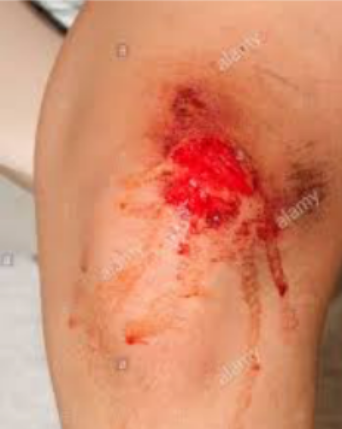
Pathophysiology of Bruising:
Capillaries rupture, leaking RBCs into the tissue.
RBCs are not reabsorbed into circulation.
They deoxygenate,
are phagocytosed
broken down → colour changes.
tearing/ laceration wounds
Vulnus laceratum
caused by blunt mechanical trauma
tears or rips the skin and underlying tissues.
Shearing or stretching force applied to the skin
Falls
Being scraped by a rough object (e.g., tree branch, machinery)
Road traffic accidents
Irregular/ torn border- ragged, rough edges
deep or superficial (only epidermis)
Infection risk due to contamination and irregular shape

Lacerated-Contused Wound
VULNUS LACERO-CONTUSUM
mixed wound caused by blunt trauma
Laceration (tear) of the skin/tissues
contusion (bruising/crushing) of surrounding soft tissue
Frequently occurs on the scalp
Example: Brick or heavy object falls on head
Morphology
wound edges are irregular
injury to the skin, subcutaneous tissue, muscos and even bone
can cause internal bleeding, hematoma, bone fractures
surrounding tisssue- heavily contused, maybe necrotic
Teta = covered wound DANGEROUS —> Traumatic shock and anaerobic/ gas infection
Aperta = open wound, more visible but easier to clean and manage
Treatment
Treat = skin graft/ microvascular scalp preserving surgery
puncture wound
VULNUS PUNCTUM
caused by a long, thin, pointed object
that penetrates deeply into the tissues
creating a narrow, deep tract.
Nails, needles, thorns, screwdrivers, knives (in a stabbing motion)
Small entry point, often misleading
Deep penetration through skin, subcutis, muscle, and potentially into body cavities
looks minor, significant trauma
complications
Anaerobic infections (due to narrow, poorly oxygenated tract)
Especially Tetanus, Gas gangrene
Foreign body retention (wood, rust, dirt)
Sealed wound = high risk if surface heals first, trapping infection
Organ injury if penetrating:
Pneumothorax (chest)
Peritonitis (abdomen)
Pericarditis or cardiac tamponade (heart)
Treatment:
Do not close immediately
Drainage is crucial
May require wound exploration, foreign body removal
Tetanus prophylaxis
Antibiotics (especially against anaerobes)
Stab wound
by knife, so wider wound, less trauma,
more pain and haemorrhage
less chance of a foreign body
less chance of infection
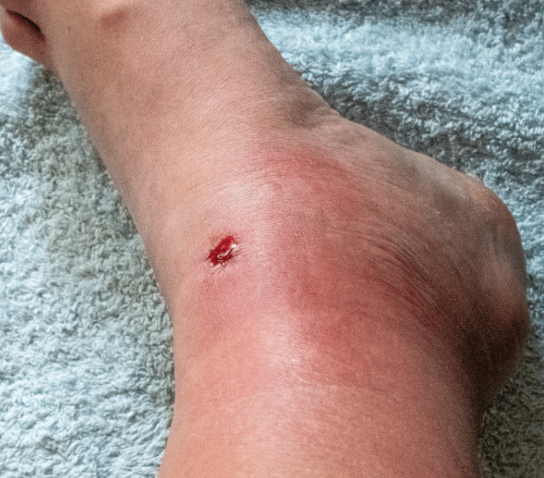
bite wound
VULNUS MORSUM
Animal or bug bite
tearing, puncturing, or crushing of the skin and soft tissues.
Swelling/Oedema
Painfull
Allergies and complications are DANGEROUS
(rabies, poison, malaria, anaphylactic shock...)
Bacteria in saliva and venom = ↑ infection risk
Dog- Et canicus
tearing or crushing wound
Rabies
Pasteurella, Capnocytophaga infections
Insect- Et insecticidus
Allergic reactions
Disease transmission (e.g., malaria, dengue, Lyme)
Snake - Et serpentibus
2 puncture points
venom
increase in HR
oedema
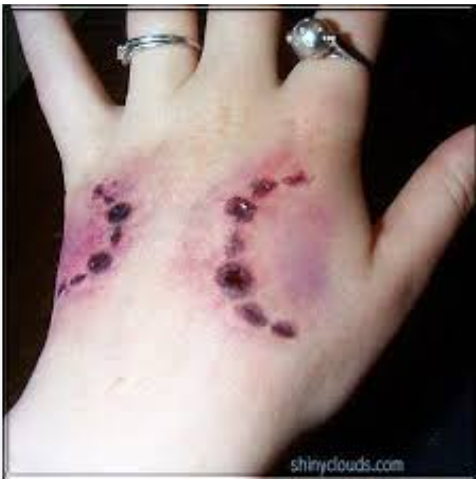
gunshot wound
VULNUS SCLOROPECTUM
penetrating wound caused by a projectile (bullet) from a firearm
Bullet size (caliber) determines damage done
Velocity and energy (high-velocity = more destructive)
Distance from shooter
Rotation/spin of bullet
Tissue type and elasticity:
Elastic tissues (e.g., muscle, skin) stretch and may recover
Non-elastic tissues (e.g., brain, liver, spleen) are damaged severely
May have small entry + larger exit wound
Tissue Damage – 3 Zones:
Zone of destruction
necrotic canal
irreversible
foreign bodies
Zone of contusion
irregular bruised tissue
irreversible
Zone of concussion
outer area
vessel spasm
-Bullet fragments, shattered bones cause more wounding
Treatment:
irrigate
debridement
exploration
bullet removal
dressing
antibiotics
